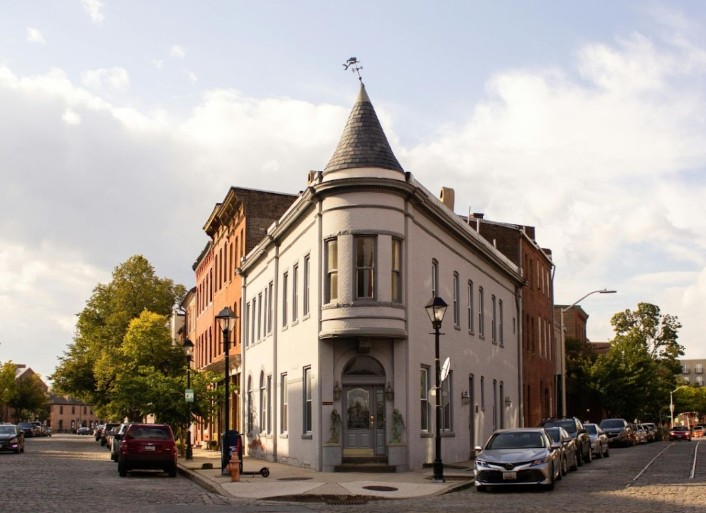Why is Housing so Inexpensive in Maryland?

Maryland’s housing market stands out when compared to its neighbors like Virginia, Delaware, and Pennsylvania. While the proximity to major job hubs such as Washington D.C. and Philadelphia might suggest higher costs, Maryland’s real estate market remains surprisingly affordable.
Photo by Abdullah Almutairi: https://www.pexels.com/photo/corner-building-at-the-cobblestone-streets-in-baltimore-maryland-5494237/
The state’s relatively lower cost of living can be attributed to its diverse economy, a mix of urban and rural areas, and a larger supply of housing compared to high-demand regions like Northern Virginia.
For homebuyers or renters, this means Maryland offers more space and better value for your money compared to nearby states.
The affordability stretches from urban centers like Baltimore to smaller towns, making it an attractive option for those looking to get more for their investment while remaining close to major cities.
Economic Shifts in Baltimore: Affordable City Living
Baltimore, Maryland’s largest city, has long been known for its affordable housing market. Economic changes over the past few decades, such as the decline of manufacturing jobs and urban flight, have left the city with an overabundance of housing stock.
Despite recent efforts to revitalize certain areas, housing prices remain low in many neighborhoods, offering a unique opportunity for buyers.
Urban Renewal vs. Housing Prices
While parts of Baltimore, like the Inner Harbor and Federal Hill, have seen significant investment and rising home values, many areas remain affordable due to ongoing economic challenges.
This affordability draws young professionals and first-time homebuyers looking for city life without the steep price tag often associated with urban living.
Overabundance of Housing Stock in Maryland’s Small Cities
Beyond Baltimore, Maryland’s smaller cities and towns contribute to the state’s low housing costs. Places like Hagerstown, Frederick, and Cumberland have more housing available than there is demand.
These areas often offer affordable living options, especially for families or individuals seeking more space without the high costs found in metropolitan regions.
Housing Supply vs. Demand
The overabundance of housing stock in smaller cities is largely due to population shifts, where many residents relocate to larger cities or out of state for better job prospects.
This surplus of homes keeps prices in check, making it easier for buyers to find reasonably priced properties.
The Impact of Deindustrialization on Housing Prices
Deindustrialization has played a significant role in shaping Maryland’s housing market. As manufacturing jobs left cities like Baltimore, Hagerstown, and others, the economic downturn led to reduced demand for housing.
The resulting economic stagnation, coupled with an excess of vacant properties, has kept housing prices from climbing in these once-thriving industrial hubs.
While some areas have seen revitalization efforts, the lingering effects of deindustrialization continue to suppress property values in parts of Maryland, contributing to the state’s reputation for affordable housing.
Affordable Suburban Options Near Major Employment Hubs
One of the key reasons housing in Maryland remains affordable is the availability of suburban options close to major employment centers like Washington, D.C., and Baltimore.
Towns such as Columbia, Glen Burnie, and Laurel offer relatively low housing costs while maintaining easy access to big-city job markets.
These suburban areas provide a balance between affordable living and proximity to high-paying jobs, making them attractive for professionals looking for more space and lower costs without sacrificing career opportunities.
Commuting options, such as MARC trains and highways, make it feasible for residents to live in these affordable suburbs while working in larger metropolitan areas.
The Suburban Advantage
These suburbs offer a variety of housing types, from single-family homes to townhouses and condos, catering to different budgets and family sizes.
The combination of affordability, quality schools, and community amenities makes them a preferred choice for those seeking the benefits of suburban life without the high price tags often found in other states.
Revitalization Efforts and Their Influence on Housing Prices in Baltimore
Baltimore has seen several revitalization projects over the years, particularly in neighborhoods like Canton, Fells Point, and Hampden. These efforts, focused on improving infrastructure, attracting businesses, and enhancing community spaces, have led to rising property values in some parts of the city.
However, these price increases remain localized, and much of Baltimore still offers affordable housing options.
Revitalization vs. Market Stability
The city’s ongoing efforts to renew certain districts have brought attention to Baltimore’s potential, but the overall housing market remains stable and affordable compared to other large cities.
This mix of revitalized and still-developing areas provides buyers with a range of options, from more expensive, modernized areas to low-cost, up-and-coming neighborhoods with long-term growth potential.
Hidden Gems: Affordable Housing in Hagerstown and Cumberland
For those willing to venture outside of Maryland’s larger cities, Hagerstown and Cumberland offer some of the most affordable housing in the state.
These smaller cities, located in western Maryland, are perfect for homebuyers looking for a quieter lifestyle at a fraction of the cost of urban living.
Why Hagerstown and Cumberland Stand Out
Both cities boast historic charm, scenic landscapes, and significantly lower housing prices compared to their eastern counterparts.
Hagerstown, known for its proximity to outdoor recreation, and Cumberland, with its rich history and small-town appeal, offer excellent opportunities for first-time buyers or retirees seeking affordable homes in more rural settings.
A Buyer’s Market: How Maryland’s Housing Surplus Keeps Prices Low
Maryland’s housing surplus plays a major role in keeping property prices affordable across the state. As industries shifted or declined, particularly in the manufacturing and industrial sectors, many areas were left with more homes than there were buyers.
This surplus creates a buyer’s market, where competition among sellers drives prices down.
The excess supply continues to offer long-term affordability, particularly in smaller cities and less densely populated areas. For buyers, this means more negotiating power and the ability to find homes at lower prices than in neighboring states. As Maryland works to balance its housing stock with demand, this buyer’s market is likely to persist, making the state an attractive destination for affordable real estate.



